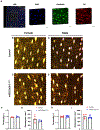miR181a/b-1 controls osteocyte metabolism and mechanical properties independently of bone morphology
- PMID: 37414200
- PMCID: PMC11156520
- DOI: 10.1016/j.bone.2023.116836
miR181a/b-1 controls osteocyte metabolism and mechanical properties independently of bone morphology
Abstract
Bone derives its ability to resist fracture from bone mass and quality concurrently; however, many questions about the molecular mechanisms controlling bone quality remain unanswered, limiting the development of diagnostics and therapeutics. Despite the increasing evidence on the importance of miR181a/b-1 in bone homeostasis and disease, whether and how osteocyte-intrinsic miR181a/b-1 controls bone quality remains elusive. Osteocyte-intrinsic deletion of miR181a/b-1 in osteocytes in vivo resulted in compromised overall bone mechanical behavior in both sexes, although the parameters affected by miR181a/b-1 varied distinctly based on sex. Furthermore, impaired fracture resistance in both sexes was unexplained by cortical bone morphology, which was altered in female mice and intact in male mice with miR181a/b-1-deficient osteocytes. The role of miR181a/b-1 in the regulation of osteocyte metabolism was apparent in bioenergetic testing of miR181a/b-1-deficient OCY454 osteocyte-like cells and transcriptomic analysis of cortical bone from mice with osteocyte-intrinsic ablation of miR181a/b-1. Altogether, this study demonstrates the control of osteocyte bioenergetics and the sexually dimorphic regulation of cortical bone morphology and mechanical properties by miR181a/b-1, hinting at the role of osteocyte metabolism in the regulation of mechanical behavior.
Keywords: Bone quality; Cell metabolism; Mechanical behavior; Microrna; Osteocyte.
Copyright © 2023. Published by Elsevier Inc.
Conflict of interest statement
Declaration of competing interest The authors have no conflict of interest to declare.
Figures






References
-
- Chang JL, Brauer DS, Johnson J, Chen CG, Akil O, Balooch G, et al., Tissue specific calibration of extracellular matrix material properties by transforming growth factor-beta and Runx2 in bone is required for hearing, EMBO Rep. 11 (10) (2010) 765–771. Epub 2010/09/18, 10.1038/embor.2010.135. Epub 2010/09/18. - DOI - PMC - PubMed
-
- Kawashima Y, Fritton JC, Yakar S, Epstein S, Schaffler MB, Jepsen KJ, et al., Type 2 diabetic mice demonstrate slender long bones with increased fragility secondary to increased osteoclastogenesis, Bone 44 (4) (2009) 648–655. Epub 2009/01/20, 10.1016/j.bone.2008.12.012. Epub 2009/01/20. - DOI - PMC - PubMed
Publication types
MeSH terms
Grants and funding
LinkOut - more resources
Full Text Sources

